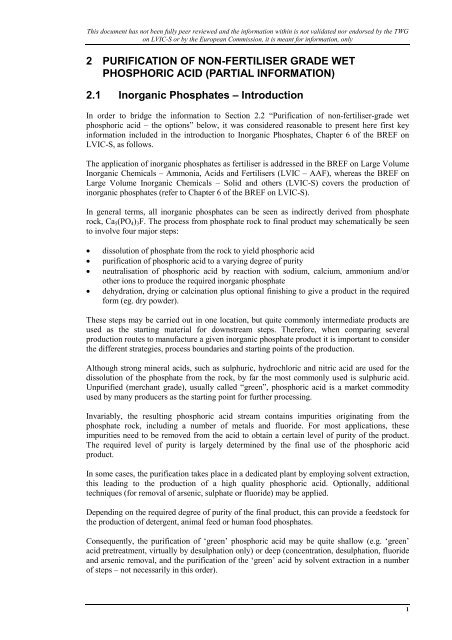Additional Information submitted during the information exchange on ...
Additional Information submitted during the information exchange on ... Additional Information submitted during the information exchange on ...
This document has not been fully peer reviewed and
- Page 1 and 2: EUROPEAN COMMISSION DIRECTORATE-GEN
- Page 3 and 4: 2 PURIFICATION OF NON-FERTILISER GR
- Page 5: List of tables Table 1.1: Typical c
- Page 9 and 10: This document has not been fully pe
- Page 11 and 12: This document has not been fully pe
- Page 13 and 14: This document has not been fully pe
- Page 15 and 16: This document has not been fully pe
- Page 17 and 18: This document has not been fully pe
- Page 19 and 20: This document has not been fully pe
- Page 21 and 22: This document has not been fully pe
- Page 23 and 24: This document has not been fully pe
- Page 25 and 26: This document has not been fully pe
- Page 27 and 28: This document has not been fully pe
- Page 29 and 30: This document has not been fully pe
- Page 31 and 32: This document has not been fully pe
- Page 33 and 34: This document has not been fully pe
- Page 35 and 36: This document has not been fully pe
- Page 37 and 38: This document has not been fully pe
- Page 39 and 40: This document has not been fully pe
- Page 41: This document has not been fully pe
- Page 45 and 46: This document has not been fully pe
- Page 47 and 48: REFERENCES References 6 CEFIC (2002
- Page 49 and 50: References 69 Environment Agency (1
- Page 51 and 52: GLOSSARY OF TERMS AND ABBREVIATIONS
- Page 53 and 54: Abbreviations of units of measure b
- Page 55 and 56: HF Hydrogen fluoride H2O Water H2O2
This document has not been fully peer reviewed and <str<strong>on</strong>g>the</str<strong>on</strong>g> <str<strong>on</strong>g>informati<strong>on</strong></str<strong>on</strong>g> within is not validated nor endorsed by <str<strong>on</strong>g>the</str<strong>on</strong>g> TWG<br />
<strong>on</strong> LVIC-S or by <str<strong>on</strong>g>the</str<strong>on</strong>g> European Commissi<strong>on</strong>, it is meant for <str<strong>on</strong>g>informati<strong>on</strong></str<strong>on</strong>g>, <strong>on</strong>ly<br />
2 PURIFICATION OF NON-FERTILISER GRADE WET<br />
PHOSPHORIC ACID (PARTIAL INFORMATION)<br />
2.1 Inorganic Phosphates – Introducti<strong>on</strong><br />
In order to bridge <str<strong>on</strong>g>the</str<strong>on</strong>g> <str<strong>on</strong>g>informati<strong>on</strong></str<strong>on</strong>g> to Secti<strong>on</strong> 2.2 “Purificati<strong>on</strong> of n<strong>on</strong>-fertiliser-grade wet<br />
phosphoric acid – <str<strong>on</strong>g>the</str<strong>on</strong>g> opti<strong>on</strong>s” below, it was c<strong>on</strong>sidered reas<strong>on</strong>able to present here first key<br />
<str<strong>on</strong>g>informati<strong>on</strong></str<strong>on</strong>g> included in <str<strong>on</strong>g>the</str<strong>on</strong>g> introducti<strong>on</strong> to Inorganic Phosphates, Chapter 6 of <str<strong>on</strong>g>the</str<strong>on</strong>g> BREF <strong>on</strong><br />
LVIC-S, as follows.<br />
The applicati<strong>on</strong> of inorganic phosphates as fertiliser is addressed in <str<strong>on</strong>g>the</str<strong>on</strong>g> BREF <strong>on</strong> Large Volume<br />
Inorganic Chemicals – Amm<strong>on</strong>ia, Acids and Fertilisers (LVIC – AAF), whereas <str<strong>on</strong>g>the</str<strong>on</strong>g> BREF <strong>on</strong><br />
Large Volume Inorganic Chemicals – Solid and o<str<strong>on</strong>g>the</str<strong>on</strong>g>rs (LVIC-S) covers <str<strong>on</strong>g>the</str<strong>on</strong>g> producti<strong>on</strong> of<br />
inorganic phosphates (refer to Chapter 6 of <str<strong>on</strong>g>the</str<strong>on</strong>g> BREF <strong>on</strong> LVIC-S).<br />
In general terms, all inorganic phosphates can be seen as indirectly derived from phosphate<br />
rock, Ca5(PO4)3F. The process from phosphate rock to final product may schematically be seen<br />
to involve four major steps:<br />
dissoluti<strong>on</strong> of phosphate from <str<strong>on</strong>g>the</str<strong>on</strong>g> rock to yield phosphoric acid<br />
purificati<strong>on</strong> of phosphoric acid to a varying degree of purity<br />
neutralisati<strong>on</strong> of phosphoric acid by reacti<strong>on</strong> with sodium, calcium, amm<strong>on</strong>ium and/or<br />
o<str<strong>on</strong>g>the</str<strong>on</strong>g>r i<strong>on</strong>s to produce <str<strong>on</strong>g>the</str<strong>on</strong>g> required inorganic phosphate<br />
dehydrati<strong>on</strong>, drying or calcinati<strong>on</strong> plus opti<strong>on</strong>al finishing to give a product in <str<strong>on</strong>g>the</str<strong>on</strong>g> required<br />
form (eg. dry powder).<br />
These steps may be carried out in <strong>on</strong>e locati<strong>on</strong>, but quite comm<strong>on</strong>ly intermediate products are<br />
used as <str<strong>on</strong>g>the</str<strong>on</strong>g> starting material for downstream steps. Therefore, when comparing several<br />
producti<strong>on</strong> routes to manufacture a given inorganic phosphate product it is important to c<strong>on</strong>sider<br />
<str<strong>on</strong>g>the</str<strong>on</strong>g> different strategies, process boundaries and starting points of <str<strong>on</strong>g>the</str<strong>on</strong>g> producti<strong>on</strong>.<br />
Although str<strong>on</strong>g mineral acids, such as sulphuric, hydrochloric and nitric acid are used for <str<strong>on</strong>g>the</str<strong>on</strong>g><br />
dissoluti<strong>on</strong> of <str<strong>on</strong>g>the</str<strong>on</strong>g> phosphate from <str<strong>on</strong>g>the</str<strong>on</strong>g> rock, by far <str<strong>on</strong>g>the</str<strong>on</strong>g> most comm<strong>on</strong>ly used is sulphuric acid.<br />
Unpurified (merchant grade), usually called “green”, phosphoric acid is a market commodity<br />
used by many producers as <str<strong>on</strong>g>the</str<strong>on</strong>g> starting point for fur<str<strong>on</strong>g>the</str<strong>on</strong>g>r processing.<br />
Invariably, <str<strong>on</strong>g>the</str<strong>on</strong>g> resulting phosphoric acid stream c<strong>on</strong>tains impurities originating from <str<strong>on</strong>g>the</str<strong>on</strong>g><br />
phosphate rock, including a number of metals and fluoride. For most applicati<strong>on</strong>s, <str<strong>on</strong>g>the</str<strong>on</strong>g>se<br />
impurities need to be removed from <str<strong>on</strong>g>the</str<strong>on</strong>g> acid to obtain a certain level of purity of <str<strong>on</strong>g>the</str<strong>on</strong>g> product.<br />
The required level of purity is largely determined by <str<strong>on</strong>g>the</str<strong>on</strong>g> final use of <str<strong>on</strong>g>the</str<strong>on</strong>g> phosphoric acid<br />
product.<br />
In some cases, <str<strong>on</strong>g>the</str<strong>on</strong>g> purificati<strong>on</strong> takes place in a dedicated plant by employing solvent extracti<strong>on</strong>,<br />
this leading to <str<strong>on</strong>g>the</str<strong>on</strong>g> producti<strong>on</strong> of a high quality phosphoric acid. Opti<strong>on</strong>ally, additi<strong>on</strong>al<br />
techniques (for removal of arsenic, sulphate or fluoride) may be applied.<br />
Depending <strong>on</strong> <str<strong>on</strong>g>the</str<strong>on</strong>g> required degree of purity of <str<strong>on</strong>g>the</str<strong>on</strong>g> final product, this can provide a feedstock for<br />
<str<strong>on</strong>g>the</str<strong>on</strong>g> producti<strong>on</strong> of detergent, animal feed or human food phosphates.<br />
C<strong>on</strong>sequently, <str<strong>on</strong>g>the</str<strong>on</strong>g> purificati<strong>on</strong> of ‘green’ phosphoric acid may be quite shallow (e.g. ‘green’<br />
acid pretreatment, virtually by desulphati<strong>on</strong> <strong>on</strong>ly) or deep (c<strong>on</strong>centrati<strong>on</strong>, desulphati<strong>on</strong>, fluoride<br />
and arsenic removal, and <str<strong>on</strong>g>the</str<strong>on</strong>g> purificati<strong>on</strong> of <str<strong>on</strong>g>the</str<strong>on</strong>g> ‘green’ acid by solvent extracti<strong>on</strong> in a number<br />
of steps – not necessarily in this order).<br />
1



